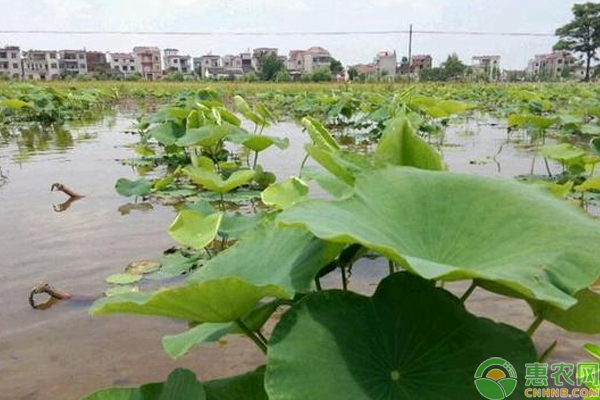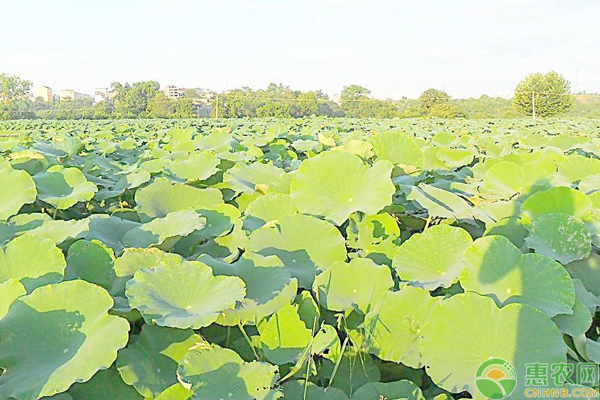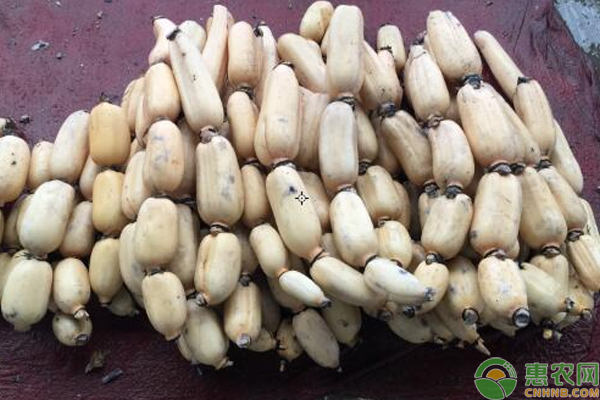Lotus roots taste the aquatic vegetables, high nutritional value and delicious, practical and fried, stewed, boiled, fried and other practices, is a very popular dish, in fact, the lotus root cultivation method is very simple, the following is a detailed cultivation method.

1 Cultivars and characteristics
1.1 'O Lian 7'
Early maturing varieties. The plant height is 110 to 130 cm, the leaf diameter is about 70 cm, and the flower is white. The main rafts are 4 to 6 knots. The internodes are short cylindrical, with even internodes. The scorpion is thick and the weight of the single stalk is 2.2 to 2.5 kg. Harvested from late June to early July.
1.2 'O Lian 6'
Medium mature varieties. The plant height is 160-180 cm, the leaf is nearly round, the surface is smooth, the blade radius is about 36 cm, the petiole is about 1.9 cm thick, and the flowering is more and the flower is white. The shape of the internodes is medium and short, and the internodes are evenly distributed. The main rafts are 6 to 7 knots, and the single squats are about 3.5 kg. In the middle of July, the output of 667 m2...the green lotus is about 1 500 kg, and the output of dry lotus is 2 000 ~...2 500 kg.
1.3 'O Lian 9' ( Big Mac)
Early and middle maturity varieties. The plant height is about 180 cm, the petiole is thick, and the leaves are nearly round and white. The middle and short cylinders of the internodes are 5 to 7 knots, the single weight is about 4 kg, and the main weight is about 2.4 kg. The yield per 667 m2 of dry lotus is 2 500 to 3 000 kg.
1.4 '东è·æ—©è—•'
Early maturing varieties. After the spring, the leaves are about 66 cm long; the number of larvae is less, the main scorpion is about 51 cm long, and the average number of internodes is 2.3. The internodes are long in shape, and the length and transverse diameter are about 20 cm and 6.7 cm, respectively. The skin is smooth, the meat is sweet and crisp, suitable for fried or raw food. The leaves of Xia'an are about 69 cm long; the branches are 1 to 2, the main length is about 62 cm, the average number of internodes is about 3.3, and the internode length and transverse diameter are about 18 cm and 7.5 cm, respectively. The growth period of spring sorghum and summer sorghum was 76 d and 75 d, respectively. The yield per 667 m2 of spring and summer sorghum is ... 1 500 kg and 2 000 kg respectively.
1.5 '飘花藕'
Early maturing varieties. The petiole is 140 cm long, with elliptic leaves and a leaf diameter of 75 cm. The main raft is 5 to 7 knots, with a length of 120 to 150 cm and a transverse diameter of 7 to 8 cm. The tip is thick and deep into the mud. At the beginning of July, the output of 667 m2 of green lotus was about 1 500 kg, and the output of old cooked carp in August was about 2 000 kg.

2 greenhouses, two cooked and double season cultivation
2.1 Variety selection
Choose early-maturing varieties such as 'Donghe Zao', 'Olian No. 7', 'Floating Flower'.
2.2 Cultivation facilities
Steel frame and bamboo frame can be selected, and 8 m steel frame and 6 m steel frame are commonly used.
2.3 species selection and processing
The spring cultivating equipment meets the characteristics of the cultivar, the complete bud, the color is fresh, the disease-free plaque is damaged, and the whole body is thick and has 3 or more knots of sorghum or scorpion. The amount of seed is 300 to 400 kg per 667 m2. Before planting, the seedlings were soaked with 25% prochloraz EC, and then planted after the drug solution was dried.
2.4 Colonization
Quzhou City, Chunzhou City generally chooses to transplant in sunny and warm weather in early March. If the greenhouse is used for small-small sheds, it can be properly cultivated early. The seedlings should be planted with the excavation. When planting, the hoe will be inserted slightly downward. ~ 15 cm, the tip of the cockroach is exposed to the mud surface, and the angle of the soil is about 20 °. The greenhouse lotus roots are cultivated at a high density, with a plant spacing of 1 to 1.5 m × 0.8 to 1 m, and a seed amount of 400 to 500 kg per 667 m2. Xia Wei was digging with the seeds during the spring excavation.
2.5 Temperature Management
In the early stage of spring sapling, the floating leaf period is mainly based on sealing and heat preservation. Generally, the film is not peeled off, and if it is cold, the water is properly irrigated. The leaves are properly ventilated after deployment. In sunny and hot weather, the temperature in the shed is higher than 35 °C, and should be ventilated in time to prevent high temperature injury. During the second leaf development period, two shed film ventilation refineries were opened every day. After the third leaf is unfolded, as the outside temperature rises, the film on one side opens and ventilates during the day, and the film is kept warm in the evening. After mid-April, the temperature was stable above 20 °C and the film was removed. Xia Wei has a high temperature in the early stage of transplanting, and can use the flat-type shading and heat insulation to prevent the water temperature from being high and inhibit the growth of weeds.
2.6 Water and fertilizer management
The water layer in the spring buds from the germination stage to the germination stage is maintained at 3 to 5 cm, the leaves are drawn to 5 to 10 cm before the closure, and the sealing period is 10 to 20 cm, and the crusting period is 5 to 10 cm. In late May, the water control was controlled to promote the expansion of new cockroaches. In the early stage of summer planting, when the temperature is above 35 °C, it is necessary to fill deep water for protection to prevent scalding and promote the early growth of seedlings. Keep the water depth more than 10 cm during the winter. Spring 藕 is generally topdressed 3 times, the first time in the 1st to 2 pieces of the leaves, 15 to 20 kg per 667 m2 of urea; the second time before the closure, 20 to 25 kg per 667 m2 of compound fertilizer; When the terminal leaves appear, apply 20-30 kg of compound fertilizer per 667 m2 and 5 to 10 kg of potassium sulfate. Put the shallow field water before fertilization, let the fertilizer inhale into the soil, and then restore the water to the original water level. Wind weather should not be carried out at noon. Xia Wei applied 50 kg of compound fertilizer in time after transplanting.

2.7 Pest Control
The main diseases are blight, brown spot and spoilage. In the early stage of the disease, 64% of the evil cream Mn-Zn WP 600 times, 72% frost urea Mn-Zn WP 800 times liquid can be used for prevention and treatment. Brown spot disease, the initial stage of the disease with 50% mancozeb WP 500 times, 30% difenoconazole EC 1 500 times, 50% prochloraz manganese salt WP 1 500 times solution. Corruption disease, when a small amount occurs, timely remove the diseased plant, bring out the field to destroy, and apply quicklime in and around the diseased area; the drug can be used 98% carbendazim SP ... 3 000 times, 30% difenoconazole EC 1 500 times, 50% imipenem manganese salt WP 1 500 times liquid and other prevention and control, can also be mixed with the above agents into the medicinal soil in the 1 to 2 leaf stage, 5 to 6 pieces of the stage of the field. The main pests are aphids and Spodoptera litura. Aphids can be alternately controlled with 70% Emerald EC 4 000 times and 10% nitenpyram AS 2 000 times solution; Spodoptera litura can be used at the peak of egg hatching to the 1st and 2nd instar larvae. In addition to EC 1 000 times, 20% chlorantraniliprole SC 2 000 times liquid and other alternate control.
2.8 timely harvest
Spring is in late May to mid-June, when many end leaves are harvested in the field. Xia Wei began harvesting in the middle and late August. For the old man to harvest, the harvest period can be extended to the beginning of April next year.
3 open field cultivation
3.1 Variety selection
Early-maturing, medium-maturing and high-yielding E-Lian series such as 'E-Lian 6', 'E-Lian 7', 'E-Lian 9' (Jubo), and 'Floating Flowers', 'Donghe 'Other varieties.
3.2 Site preparation and land preparation
Strictly selecting the land, the field requires sufficient water source, two irrigation and drainage, rich organic matter and soft soil. 10 to 15 days before the planting of lotus roots, irrigation and tillage, 2,000 m2 of organic fertilizer applied per 667 m2, 75 kg of quicklime, 50 kg of compound fertilizer, 50 kg of superphosphate, 2 kg of zinc sulfate, 2 kg of borax, 2 kg of borax Then work hard and level.
3.3 Colonization
The selection and treatment of seedlings before planting can be referred to in greenhouse cultivation. Planting in the middle and late March to the beginning of April, the plant spacing is 1.5 to 2 m × 1 m, 300 to 400 holes per 667 m2, and one or two sub-sacs are discharged from each hole. When planting, the surrounding heads are all oriented toward the field, and when the middle of the field is opposite, the line spacing is increased.
3.4 cultivating and weeding
After 15 days of planting, the cultivating and weeding was carried out once. When weeds are for a long time, weeding is carried out once every 10 days, and weeding and weeding are stopped after the lotus leaves are sealed. When weeding, it should be operated in shallow water. At the same time, it should be carried out on both sides of the rolled leaf. Do not step on the whip. The weeds and the withered leaves can be stuffed into the mud as fertilizer.
3.5 Turning tips
When the leaf is 1 m away from the edge of the field, in order to prevent the tip from crossing the field, the tip of the field near the field is turned to the field at any time, and the tip is turned every 2 to 3 days during the growing period. Turning tips should be carried out in the afternoon to avoid breaking.
3.6 Water and fertilizer management
Can refer to greenhouse cultivation.
3.7 timely harvest
Early-maturing varieties are harvested from late June to mid-July; mid-maturing varieties are harvested in mid-July... and harvested before mid-August.
Lotus root planting has a very good prospect of planting because it can not only be eaten, but also can be used as ornamental flowers, and the market demand is large. If you want to develop the planting industry, you can try the lotus root cultivation techniques shared by Xiaobian.
Being a reliable supplier of above products, Medton works under the following main principles: quality, credit, innovation, and close partnership with customers.
Marine Lifeguard Rescue
Medton Medical , https://www.medtonmedical.com